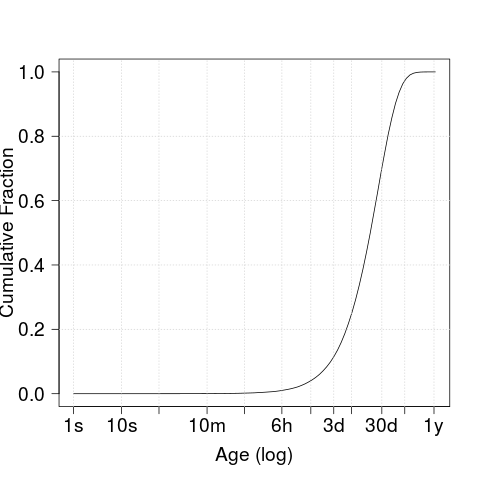Supported by Dr. Osamu Ogasawara and  providing providing  . . |
|
Last data update: 2014.03.03 |
Plot Binned Histogram and ECDF Data.DescriptionProduces aesthetically pleasing ECDF plots for two common classes of non-equiwidth histograms. Specifically, (1) histograms with power of two bucket boundaries commonly used in computer science for measuring resource usage, and (2) histograms with log-scaled time duration buckets with a range from 1 second to 10 years. Usage
PlotLog2ByteEcdf(x, xlab="Bytes (log)",
ylab="Cumulative Fraction", with.grid=TRUE, ...)
PlotLogTimeDurationEcdf(x, with.grid=TRUE,
xlab="Age (log)",
ylab="Cumulative Fraction",
cex.lab=1.6,
cex.axis=1.6, ...)
Arguments
DetailsThe The Author(s)Murray Stokely mstokely@google.com See Also
Examples
filename <- system.file("unitTests/data/buildkernel-readsize-dtrace.txt",
package="HistogramTools")
dtrace.hists <- ReadHistogramsFromDtraceOutputFile(filename)
x <- SubsetHistogram(dtrace.hists[["TOTAL"]], minbreak=1)
PlotLog2ByteEcdf(x, cex.lab=1.4)
x <- rexp(100000)
x <- x*(86400*300)/diff(range(x))
n <- as.integer(1+log2(max(x)))
h <- hist(x, breaks=c(0, unique(as.integer(2^seq(from=0, to=n, by=.25)))))
PlotLogTimeDurationEcdf(h)
Results
R version 3.3.1 (2016-06-21) -- "Bug in Your Hair"
Copyright (C) 2016 The R Foundation for Statistical Computing
Platform: x86_64-pc-linux-gnu (64-bit)
R is free software and comes with ABSOLUTELY NO WARRANTY.
You are welcome to redistribute it under certain conditions.
Type 'license()' or 'licence()' for distribution details.
R is a collaborative project with many contributors.
Type 'contributors()' for more information and
'citation()' on how to cite R or R packages in publications.
Type 'demo()' for some demos, 'help()' for on-line help, or
'help.start()' for an HTML browser interface to help.
Type 'q()' to quit R.
> library(HistogramTools)
> png(filename="/home/ddbj/snapshot/RGM3/R_CC/result/HistogramTools/plot.Rd_%03d_medium.png", width=480, height=480)
> ### Name: PlotLog2ByteEcdf
> ### Title: Plot Binned Histogram and ECDF Data.
> ### Aliases: PlotLog2ByteEcdf PlotLogTimeDurationEcdf
>
> ### ** Examples
>
> filename <- system.file("unitTests/data/buildkernel-readsize-dtrace.txt",
+ package="HistogramTools")
> dtrace.hists <- ReadHistogramsFromDtraceOutputFile(filename)
> x <- SubsetHistogram(dtrace.hists[["TOTAL"]], minbreak=1)
> PlotLog2ByteEcdf(x, cex.lab=1.4)
>
> x <- rexp(100000)
> x <- x*(86400*300)/diff(range(x))
>
> n <- as.integer(1+log2(max(x)))
>
> h <- hist(x, breaks=c(0, unique(as.integer(2^seq(from=0, to=n, by=.25)))))
> PlotLogTimeDurationEcdf(h)
Warning message:
In xy.coords(x, y, xlabel, ylabel, log) :
1 x value <= 0 omitted from logarithmic plot
>
>
>
>
>
> dev.off()
null device
1
>
|


